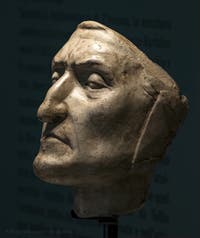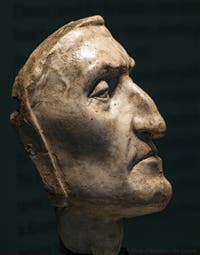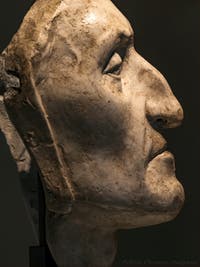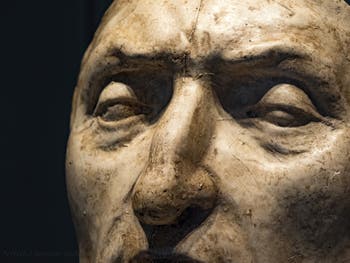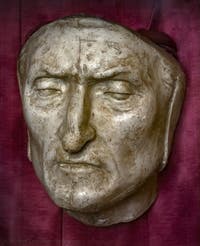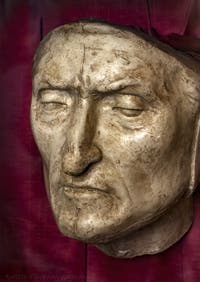Palazzo Vecchio Art Story | Location | Opening Hours Tickets | Authorizations
Art Story Five-Hundred | Tower | Vasari Halls | Dante Mask | Ghirlandaio | Bronzino Sarto Daddi | Salviati | Cortile
Dante Alighieri's Death Mask at Palazzo Vecchio in Florence in Italy
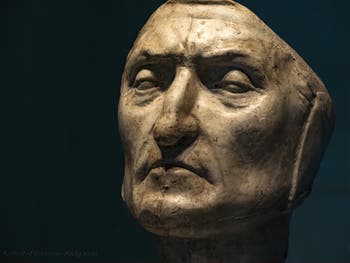
Dante Death Mask It has long been thought that Dante's funeral mask was applied directly to her face after his death in 1321.
In reality, it is only a plaster copy from the original that was probably wax.
Since Dante's reputation had gained such extent over the centuries, it would then have decided to reproduce the said original mask taking its imprint, but this time in plaster.
This mask picked up on the original body mask, now disappeared, thus represents Dante's true face.
The art of funeral masks in Florence and Dante Death Mask.
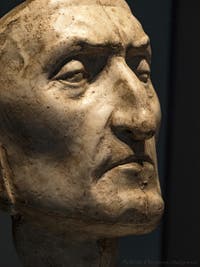
Dante Death Mask But according to the painter, writer and architect Giorgio Vasari, funerary masks were not started in Florence until the mid-15th century onwards.
But this is one Vasari's historical mistake in his famous book on “Life of Artists”.
There is evidence of this funerary art’s practice: the mortuary mask of architect Brunelleschi, made in 1445, now exhibited in the Opera Museum of the Duomo in Florence.
Dante's funeral mask would have been executed more than a century before that one of Brunelleschi, at a time when, according to Vasari, it was not done yet in Florence.
Two objections can be raised to this so-called impossibility.
First, Dante did not die in Florence, but in Ravenna, a city central between Florence and Venice.
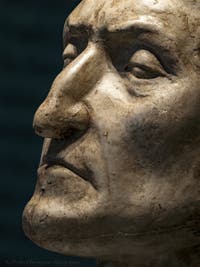
Dante Death Mask Therefore, this funerary art could be practised in this region before its emergence in Florence, especially since it is not difficult to make a wax mask.
Finally, the poet Dante's notoriety was so great that it is easy to understand that his friend and protector Guido Novello in Ravenna wanted to preserve the genius's traits and memory after his death.
This first mortuary mask would have been made to be a model for the head of the statue he had commissioned in honour of his friend.
Dante's original funeral mask
A Florentine antique dealer, Giovanni Cinelli, who died in 1706, wrote that Ravenna's archbishop had the poet's head removed from Dante's tomb's ornaments and was then offered to the sculptor Giambologna.Giambologna himself gave it as an inheritance to his pupil Pietro Tacca.
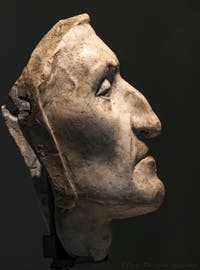
Dante Death Mask Then Pietro Tacca showed this head to Duchess Sforza, who would have taken it with her.
It is believed that this “head” mentioned by Cinelli was Dante's original funeral wax mask.
Seymour Kirkup and the portrait of Dante by Giotto
Seymour Kirkup (1788-1880) was a painter and antique dealer at the origin of discovering Dante's portrait in a fresco by Giotto, located in the Bargello chapel Museum Palace.He was also one of the owners of this Dante mask.
According to Kirkup, three Dante masks were made from the original funeral mask.
The differences between these three masks were minimal because they were due only to slight variations directly related to the original mask's fingerprinting process.
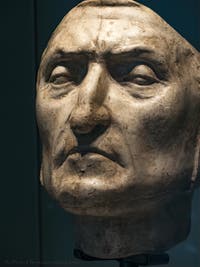
Dante Death Mask One of these masks was donated by Kirkup to the sculptor Bartolini; another belonged to Professor Ricci and the third to the Marquis Torrigiani.
Ricci's mask was then acquired by Kirkup and would have served as a model for Dante's statue in front of Santa Croce's church in Florence.
The plaster mask you can admire today at the Palazzo Vecchio belonged to the Marquis Torrigiani, although other experts mean Bartolini's one.
Evidence of the Truth of Dante's Mortuary Mask
Although there is no definite evidence that this funeral mask imprint would be that of Dante's face, its authenticity is reinforced by the fact that it is consistent with all the poet's known portraits.Giotto's portrait, which can be seen in the chapel of the Bargello Museum in Florence, painted thirty years before Dante's death, has identical features.
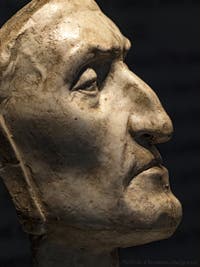
Dante Death Mask The mask itself and its slight defects confirm that it is not a mask created from scratch, for example, from known portraits, but rather the imprint of a body mask made from a dead man's face.
This face shows a difference between its two sides, the slight deviation of the nose's line and the folds of the mouth's corners.
It should also be noted the half-open eyes and remark one is a bit more shut than the other, an element consistent with the taking of an imprint on the face of a dead person.
All these clues suggest that this is indeed the funeral mask made from the face of Dante Alighieri.
Finally, after comparing the size, studied the proportions and correspondence between Giotto's portrait, the funerary mask, and Dante's supposed skull, everyone tallies with others to prove that it is indeed the same person; therefore, this funeral mask is Dante's.
It is so present that you could almost feel the breath of the great poet when you are facing him!
Tours Tickets Uffizi | Accademia | Duomo | Museums | Churches | Florence | Taste | Getaways
Art Story Five-Hundred | Tower | Vasari Halls | Dante Mask | Ghirlandaio | Bronzino Sarto Daddi | Salviati | Cortile
Palazzo Vecchio Art Story | Location | Opening Hours Tickets | Authorizations
Back to Top of Page


